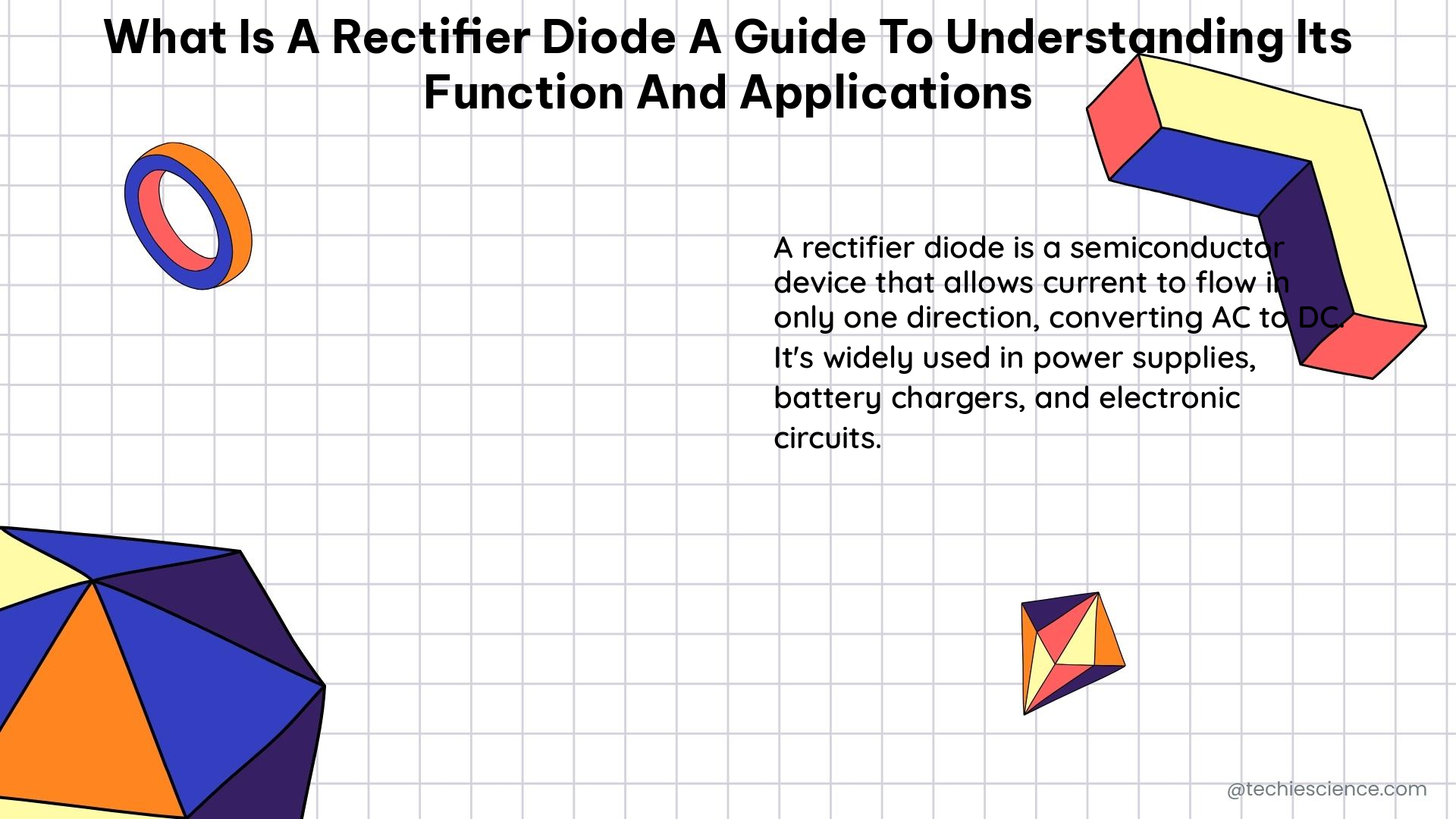A rectifier diode is a semiconductor device that plays a crucial role in converting alternating current (AC) to direct current (DC) in various electronic and electrical systems. This comprehensive guide delves into the intricacies of rectifier diodes, exploring their function, applications, and technical specifications to provide a thorough understanding for electronics enthusiasts and professionals.
Understanding the Rectifier Diode
A rectifier diode is a two-terminal semiconductor device that allows the flow of current in one direction while restricting it in the opposite direction. The two electrodes of a rectifier diode are called the anode (A) and the cathode (K), and current flows when the anode electrode is at a positive potential relative to the cathode.
Rectifier Diode Characteristics
Rectifier diodes exhibit the following key characteristics:
- Unidirectional Current Flow: Rectifier diodes allow current to flow in only one direction, from the anode to the cathode. This property is essential for converting AC to DC.
- Forward Bias and Reverse Bias: When the anode is at a positive potential compared to the cathode, the diode is said to be in forward bias, allowing current to flow. Conversely, when the anode is at a negative potential, the diode is in reverse bias, and current flow is restricted.
- Forward Voltage Drop: When a rectifier diode is in forward bias, it exhibits a small voltage drop, typically ranging from 0.6 to 1.2 volts, depending on the diode’s material and construction.
- Reverse Breakdown Voltage: Rectifier diodes have a maximum reverse voltage rating, known as the reverse breakdown voltage, beyond which the diode may be damaged or destroyed.
Types of Rectifier Diodes
Rectifier diodes come in various types, each with its own characteristics and applications:
- Half-Wave Rectifier Diodes: These diodes convert only one-half of the AC waveform, resulting in a pulsating DC output.
- Full-Wave Rectifier Diodes: These diodes convert both the positive and negative half-cycles of the AC waveform, providing a smoother DC output.
- Bridge Rectifier Diodes: A bridge rectifier consists of four diodes arranged in a bridge configuration, allowing for full-wave rectification with a higher efficiency compared to half-wave rectifiers.
- High-Power Rectifier Diodes: These diodes are designed to handle high current and voltage levels, making them suitable for industrial and high-power applications.
- Fast Recovery Rectifier Diodes: These diodes have a faster switching speed, allowing them to operate at higher frequencies and in more demanding applications.
Rectifier Diode Applications

Rectifier diodes are widely used in a variety of electronic and electrical systems, including:
- Power Supplies: Rectifier diodes are the backbone of power supply circuits, converting AC mains power to the required DC voltage for electronic devices.
- Battery Chargers: Rectifier diodes are essential components in battery chargers, ensuring the proper conversion of AC to DC for charging batteries.
- Automotive Electronics: Rectifier diodes are used in automotive electrical systems to convert the AC generated by the alternator to DC for powering various components and charging the battery.
- Industrial Automation: Rectifier diodes play a crucial role in industrial automation and control systems, where they are used for power conversion and control.
- Household Appliances: Rectifier diodes are found in a wide range of household appliances, such as televisions, refrigerators, and washing machines, for power conversion and control.
Rectifier Diode Performance Metrics
Rectifier diodes are evaluated based on several performance metrics, including:
- Rectification Efficiency: The ratio of the DC output power to the AC input power, which determines the overall efficiency of the rectification process.
- Ripple Factor: The measure of the AC component present in the DC output, which should be minimized for a smooth and stable DC supply.
- Transformer Utilization Factor (TUF): A measure of the effective utilization of the transformer in a rectifier circuit, which is higher for bridge rectifier configurations.
- Peak Inverse Voltage (PIV): The maximum reverse voltage that a rectifier diode can withstand without being damaged.
- Forward Current Rating: The maximum current a rectifier diode can handle in the forward bias condition without exceeding its thermal limits.
Rectifier Diode Testing and Troubleshooting
Proper testing and troubleshooting of rectifier diodes are essential for ensuring their reliable operation and the overall performance of the electronic system. Some common testing methods include:
- Forward Bias Test: Measuring the forward voltage drop of the diode to ensure it falls within the expected range.
- Reverse Bias Test: Checking the diode’s resistance in the reverse bias condition to verify its ability to block current flow.
- Ohmmeter Test: Using an ohmmeter to measure the diode’s resistance in both forward and reverse bias conditions.
- Multimeter Test: Utilizing a digital multimeter’s diode test function to quickly assess the diode’s functionality.
By understanding the technical details and applications of rectifier diodes, electronics enthusiasts and professionals can make informed decisions when designing, troubleshooting, and maintaining electronic systems that rely on these essential semiconductor devices.
References:
- Functions of Rectifier Diodes | Americas – United States, Toshiba.
- What is Rectifier? – Know its uses and applications, BYJU’S.
- What is a Rectifier Diode: Working and Applications – NextPCB.
- Diode as a Rectifier – Definition, Working Principle, Application, Testbook.
- Applications of Diodes | Rectifier, Clipper, Reverse Current Protection, Electronics Hub.

The lambdageeks.com Core SME Team is a group of experienced subject matter experts from diverse scientific and technical fields including Physics, Chemistry, Technology,Electronics & Electrical Engineering, Automotive, Mechanical Engineering. Our team collaborates to create high-quality, well-researched articles on a wide range of science and technology topics for the lambdageeks.com website.
All Our Senior SME are having more than 7 Years of experience in the respective fields . They are either Working Industry Professionals or assocaited With different Universities. Refer Our Authors Page to get to know About our Core SMEs.